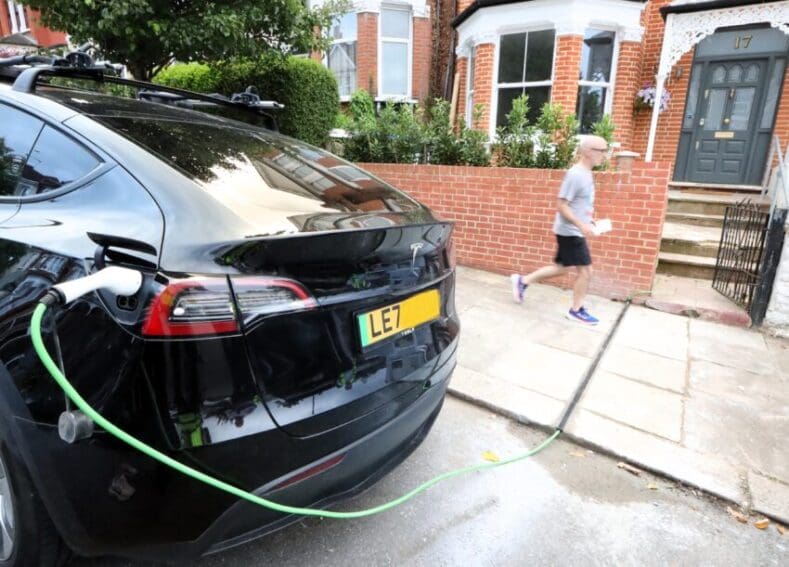
We need rapid rule changes to unlock on-street charging potential
Jordan Brompton, co-founder and CMO of myenergi, explores the latest advances in cross-pavement charging solutions, and explains why regulatory change is vital to improving access for drivers without off-street parking.
According to the Society of Motor Manufacturers and Traders (SMMT), the UK’s transition to electrification is accelerating fast. In October alone, 43,634 new plug-in cars – EV and plug-in hybrid – were registered nationwide, some 30% of total sales.
To date in 2024, almost half a million plug-in vehicles have already been registered (438,508), representing a 16% year-on-year rise, while petrol and diesel sales have both fallen (-1.8% and -12.8% respectively). This means that, within the past four weeks, we’ve officially surpassed the UK’s 2,000,000th plug-in car registration milestone.
Rather than a bubble set to burst, the mass transition to electrification is now inevitable. Indeed, by 2030, the Energy Saving Trust (EST) estimates that UK roads will play host to between 8 and 11 million electric or hybrid cars. By 2035, this number will have likely doubled.
Is the UK’s charging infrastructure keeping up?
The development of public and private charging is progressing at a remarkable rate. According to Zapmap, there were 71,459 public charging points operational across the UK as of the end of October, comprising 108,633 connectors across 36,060 locations. This represents an increase of more than 38% year-on-year, with 30,815 (43%) devices classified as either fast, rapid or ultra-rapid.
But that’s not all. Data from ChargeUK suggests that, when combined with private and destination charging, there are now more than a million devices operational nationwide.
As a result of this collective progress, an estimated 15 billion UK miles are now powered by electricity per annum. What’s more, thanks to the rise of smart devices, solar compatible technologies and renewable energy charging stations, an increasing number are powered entirely by renewable energy. It’s a truly monumental shift that’s been achieved in a short space of time and one that will define the industry for years to come.
Concerns over infrastructure and access to charging are quickly becoming yesterday’s news. EV infrastructure is clearly racing ahead, with ChargeUK stating that there is around £6 billion of private capital ready to be invested to meet the need.
But what about on-street charging?
While the reliability and convenience of using the public charging network is now enshrined in law, there is arguably still work to be done to ensure that public charge points are as accessible as possible for all drivers, including via the PAS 1899 guidelines on accessibility.
Many users of the public charging network will be from the estimated 40% of households that lack dedicated off-street parking. Historically, these drivers have been considered out-of-scope for home charging, as well as the benefits of cheaper energy tariffs and charging convenience.
However, thanks to advances in cross-pavement charging solutions, this could all be set to change. Companies like Kerbo Charge have created innovative solutions to allow homes without driveways to charge on-street with ease. Kerbo Charge’s unique charging channels, which are effectively flexible cable gullies, are sunk into the pavement between the property and the street, providing a simple, safe and secure way to connect to a home charger.
Thanks to a partnership between myenergi and Kerbo Charge, EV owners can now arrange for an access channel to be fitted in combination with our zappi EV charger in one package.
Why legislative change is key
Despite the terrific potential of cross-pavement charging solutions, however, there remains a catch. While every local authority in the UK provides a simple and standardised process for residents to apply for a dropped kerb, there isn’t yet a uniform approach to applying for a dedicated EV charging channel.
We believe that a standardised process should be available to enable households to apply for a dedicated EV charging channel quickly and simply. As such, we’re calling on the government to urgently publish guidance for local authorities on the use of safe cross pavement solutions, which was initially promised in its ‘Plan for Drivers’ published in 2023.
After all, in the 12 months since the report was published, more than half a million new plug-in cars have been registered, yet many local authorities remain unsure about how to enable these important new innovations.
The future’s bright
While we may have surpassed the UK’s two millionth plug-in car registration milestone, this is no time to be complacent. With the 2035 ban on new petrol and diesel car and van sales looming, removing further barriers to EV adoption remains pivotal to maintaining momentum in the UK’s transition to electrification.
Thanks to extensive progress from across the supply chain, EVs now boast state-of-the-art driving technologies, extensive battery ranges and low maintenance requirements – all at a more competitive price than ever before. What’s more, the public charging network is developing fast, as is the roll-out of home charging and destination charging, meaning range anxiety is quickly becoming a thing of the past.
The challenge, however, goes beyond convincing drivers to adopt EVs. Instead, it’s about ensuring they have access to the latest, smartest, cheapest and most convenient charging solutions critical to making the transition as equitable and accessible as possible.
With a lack of driveway access proving a barrier to EV adoption for some, companies like Kerbo Charge can provide the solution. However, legislative change is essential to make the whole process simple and uniform. That’s why, at myenergi, we’re calling for decisive government action – together, let’s make electrification easy.